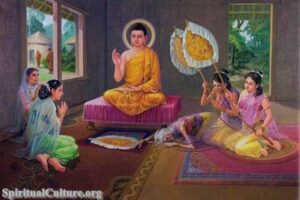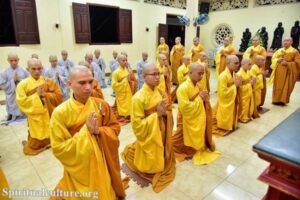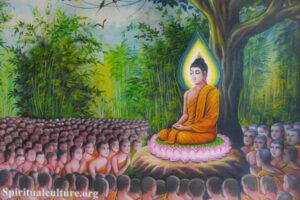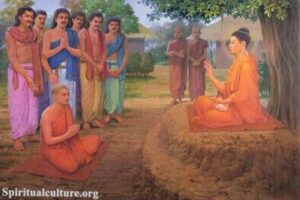Who is Guanyin bodhisattva?
Guanyin (also spelled Guan Yin or Kuan Yin) is a bodhisattva in Mahayana Buddhism who represents compassion and is often depicted as a female figure.
The name Guanyin is short for Guanshiyin, which means “Observing the Sounds (or Cries) of the World.” Guanyin is often depicted as a female figure and is sometimes referred to as the “Goddess of Mercy” or the “Divine Mother.”
She is known as the “Goddess of Mercy” in English and is one of the most popular deities in Chinese, Japanese, and Korean Buddhism.
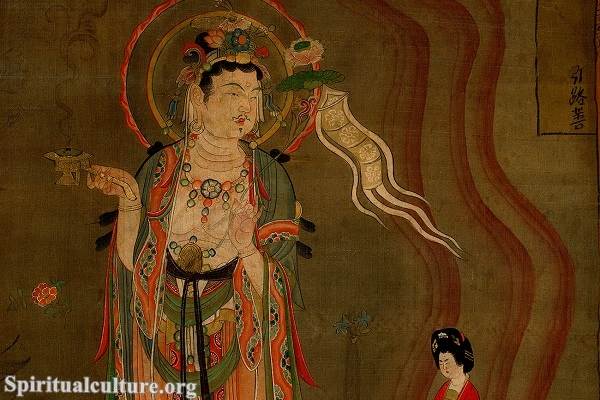
Guanyin is believed to hear the cries of the suffering and to come to the aid of those who call upon her. She is also associated with protecting children and women and is often invoked by sailors and fishermen for safe passage.
In Chinese and Japanese Buddhism, Guanyin is also associated with the idea of the bodhisattva of the Thousand Hands and Eyes, who can see and hear the suffering of all beings and respond to their needs.
Guanyin bodhisattva meaning
Guanyin is one of the most revered and beloved figures in East Asian Buddhism and is often depicted as a beautiful, serene woman holding a vase or water jar.
The vase represents the “water of compassion” that Guanyin uses to extinguish the “fires of suffering” in the world. She is also commonly depicted holding a willow branch or a lotus flower. The willow branch symbolizes her ability to relieve suffering, while the lotus flower represents her purity and detachment from the world.
Guanyin is the embodiment of compassion and is believed to hear the cries of those who are suffering and to come to their aid. She is often invoked by those who are ill, in danger or going through difficult times. She is also associated with protecting children and women and is often invoked by sailors and fishermen for safe passage.
In Chinese Buddhism, Guanyin is seen as the female counterpart of Avalokiteshvara, the bodhisattva of compassion in Indian Buddhism. She is known as Kannon in Japan, and in Korea, she is known as Kwanseum. In Chinese, Guanyin is also known as the “Goddess of Mercy” and is often depicted as a motherly figure, nurturing and caring for her devotees.
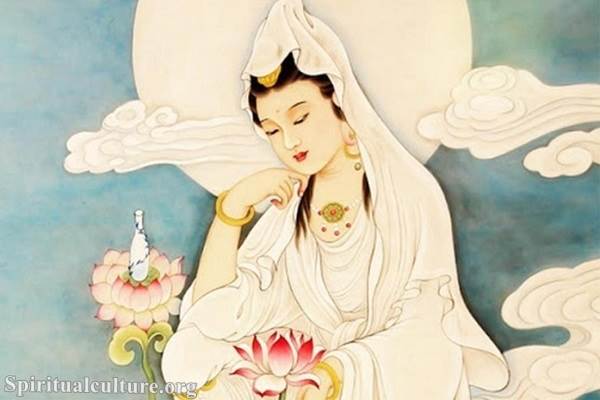
Guanyin is often depicted in a variety of forms, each with a different aspect of her compassion. Some of these forms include “Guanyin of the Thousand Arms and Eyes” and “Guanyin of the Fish Basket.” The former represents her ability to see and hear the suffering of all beings, while the latter represents her ability to save beings from the sea of suffering.
In addition to her role as a compassionate savior and protector, Guanyin is also revered as a powerful spiritual guide and teacher. She is said to have the ability to grant wishes, grant enlightenment, and even perform miracles. Her followers believe that by invoking her name, making offerings to her, or reciting her mantras, they will receive her blessings and guidance on their spiritual path. Many of her followers also practice a form of devotion known as “Guanyin Mindfulness,” where they focus on cultivating compassion, kindness, and loving-kindness towards all beings.
Guanyin is also important in Chinese and East Asian art and culture. Her image can be found in temples, shrines, and homes across the region, and she is a popular subject of statues, sculptures, and paintings. Many Chinese and East Asian artists have also created works of art inspired by Guanyin, including traditional ink and brush paintings, porcelain figurines, and contemporary works of art.
In recent years, Guanyin has also gained popularity in the West, and her image can be found in various forms, including in art and literature. Westerners have been attracted to Guanyin’s peaceful and serene image, and she has been depicted in different forms of media, including in films, television shows, and video games.
Overall, Guanyin is a revered and beloved figure in Buddhism and is considered as a powerful symbol of compassion, kindness, and loving-kindness. She is invoked and worshipped by people of all walks of life, and her teachings and guidance are still very much alive today.
Guanyin bodhisattva stories
One popular story about Guanyin is the story of the “Weeping Girl.” In this story, a poor girl named Miao Shan is so moved by the world’s suffering that she decides to become a nun. Her father, the king, is so outraged by this decision that he orders her executed. As she is about to be killed, the goddess Guanyin appears and takes Miao Shan away to be her student. Eventually, Miao Shan becomes Guanyin herself and is able to help all those who call upon her for aid.
Another popular story is the story of the “Shengfo” or “The Voice of the Sacred.” A poor fisherman called Fa Hai saves a fish from the sea and returns it to the water. The fish turns out to be a dragon prince who is about to be punished by the Dragon King of the East Sea for misdeeds. The dragon prince tells Fa Hai that he will repay his kindness by asking the bodhisattva Guanyin to help him when he needs it most. Years later, when Fa Hai is falsely accused of a crime, he calls out to Guanyin for help, and she appears to clear his name.
In both stories, Guanyin is the embodiment of compassion and is willing to help anyone in need, regardless of their situation or background.
Another well-known story about Guanyin is the “Story of the White Snake.” In this Chinese folk tale, a young scholar named Xu Xian falls in love with a beautiful woman named Bai Suzhen, who is actually a white snake spirit. Guanyin, who is disguised as an old woman, helps Xu Xian and Bai Suzhen overcome the obstacles they face and eventually marry. But when a monk named Fahai discovers that Bai Suzhen is a snake spirit, he separates them and imprisons her. Once again, Guanyin comes to their aid and helps Bai Suzhen escape and be reunited with Xu Xian.
Another story is “The Story of the Acolyte,” where a young acolyte is too lazy to study Buddhism and instead spends his days daydreaming and loitering. One day, Guanyin appears to him in a vision and tells him that she will give him a task, which he must complete before the end of the day for him to achieve enlightenment. This task is to retrieve a willow branch from the dragon palace of the East Sea. The acolyte completes the task and returns the willow branch to Guanyin, who then reveals that the task was a test of his determination and that he has passed.
All these stories illustrate Guanyin’s role as a protector and helper to those in need and the power of compassion in overcoming obstacles and achieving enlightenment.
